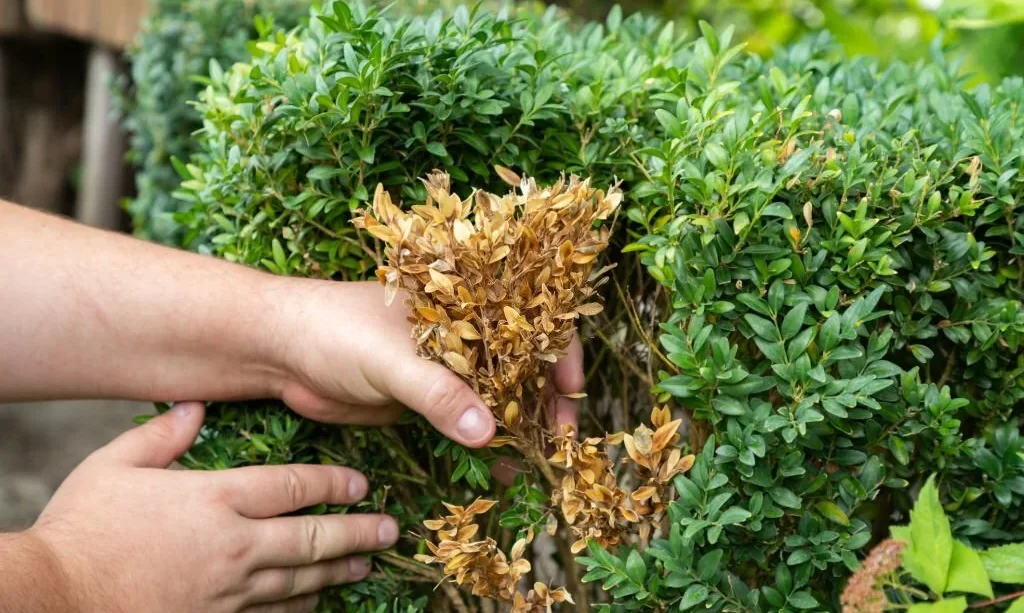Shrubs are the backbone of many gardens and landscapes, providing structure, color, and texture. However, when these stalwart plants begin to show signs of decline and distress, it can be disheartening. Reviving dying shrubs requires a thoughtful and systematic approach. In this comprehensive guide, we will explore the steps you need to take to breathe new life into your struggling shrubs. It all begins with understanding the issues at hand, diagnosing the problem, and then taking the right steps to rejuvenate your green companions. With the proper care and attention, your shrubs can once again thrive, adding beauty and vitality to your outdoor spaces.
- 12 MONTH PROTECTION: With just one application, kills listed insects and prevents new infestations for up to a year
- INSECT and PEST KILLER: Kills Japanese Beetles, Emerald Ash Borers, Adelgids, Leafminers, Aphids, Caterpillars, and more
- SLOW-RELEASE FERTILIZER: Plant food and fertilizer improves the health of your trees and shrubs
- SYSTEMIC PROTECTION: Protects your potted and outdoor trees and shrubs from the roots to the stem of every leaf
- RESTRICTIONS: Product intended only for non-bearing fruit and nut trees. Non-bearing fruits and nuts are plants that do not bear edible fruits and nuts for at least 12 months after application of pesticides. Not for sale in NY, CT, CO, MD, MA, ME, and VT.
Diagnosing the Problem
The first step in reviving a dying shrub is to identify the root cause of its decline. There are several potential issues that could be at play, from watering problems to pest infestations and diseases. By diagnosing the problem accurately, you can tailor your revival efforts to address the specific issues affecting your shrub. Common causes include overwatering, underwatering, poor soil conditions, pest damage, diseases, or incorrect planting. Careful observation and research will help you pinpoint the problem.
Pruning and Trimming
Pruning and trimming are vital steps in the revival process. These techniques help improve the shrub’s overall health and appearance. Start by removing dead or damaged branches and foliage. Pruning helps the shrub allocate its resources more efficiently, allowing it to focus on healthy growth. When shaping the shrub, consider the desired form and size, but avoid over-pruning, which can stress the plant. Proper pruning and trimming set the stage for the shrub’s recovery and promote healthy new growth.
Soil Assessment and Improvement
The soil in which your shrub grows plays a crucial role in its overall health. To improve the condition of your shrub, you must assess and amend the soil as needed. Start by conducting a soil test to determine its pH and nutrient levels. Once you have this information, you can tailor your soil improvement efforts to meet your shrub’s specific needs. Amending the soil with organic matter, compost, or targeted nutrients based on the soil test results can provide the ideal environment for your shrub to thrive. Healthy soil provides a solid foundation for the revitalization of your struggling shrub.
Proper Watering Techniques
Water is a lifeline for shrubs, but improper watering can lead to their decline. The key is to establish a consistent and appropriate watering schedule. Ensure the soil remains evenly moist without becoming waterlogged. Avoid both drought stress and overhydration. Consider factors like weather conditions and the shrub’s specific water requirements. Proper watering techniques, such as deep, infrequent watering, can help your shrub regain its vigor and vitality.
Pest and Disease Control
Pests and diseases can wreak havoc on a shrub’s health. To revive a dying shrub, you must address these issues promptly. Learn to recognize common pests and diseases that affect shrubs and implement organic or chemical control methods as necessary. Prevention is often the best approach, so employ practices to deter pests and maintain overall garden health. Effective control measures include maintaining a clean garden environment, pruning affected branches, and using appropriate treatments. By addressing pest and disease issues, you can protect your shrub from further harm and promote its recovery and future growth.
Fertilization
Fertilization is a fundamental aspect of reviving a dying shrub. Providing your shrub with the right nutrients ensures it has the energy and resources needed for recovery and growth. Choose a balanced fertilizer suitable for your shrub’s type and follow recommended application rates. It’s essential to feed your shrub at the right time during the growing season, typically in spring or early summer. Be cautious not to over-fertilize, as this can harm your plant. Proper fertilization contributes to the shrub’s overall health, helping it rebound and flourish.
Mulching
Mulching serves as an invaluable tool in the effort to revive a dying shrub. A layer of mulch around the shrub’s base has multiple benefits. It helps retain soil moisture, which is crucial for plant recovery, and regulates temperature fluctuations, protecting the roots from extreme conditions. Additionally, mulch acts as a barrier against weeds that can compete with the shrub for essential nutrients. Select an appropriate mulch material, such as organic matter, wood chips, or bark, and apply it to the soil surface while avoiding contact with the shrub’s trunk. Mulching not only aids in the revival process but also promotes long-term shrub health.
Sunlight and Pruning
Sunlight and pruning play pivotal roles in the care and revival of your shrub. It’s essential to provide your shrub with the appropriate amount of sunlight. While specific requirements vary by shrub species, most shrubs thrive in areas with plenty of direct or indirect sunlight. Ensuring your shrub receives the right light conditions will contribute to its overall well-being.
In terms of pruning, selective trimming helps maintain the shrub’s shape and encourages healthy growth. Remove dead or diseased branches, as well as any stems that cross or compete with others. Proper pruning techniques also include shaping the shrub, which can help it recover from previous stress or damage. Be cautious not to over-prune, as this can further stress the plant. By offering your shrub the correct amount of sunlight and employing thoughtful pruning, you create an environment conducive to revitalization and sustained health.
Regular Maintenance
The path to reviving a dying shrub doesn’t end with the initial efforts. Regular maintenance is a critical component of ensuring your shrub’s long-term health and vitality. This involves consistent care routines, including routine inspections, pruning to remove dead or damaged growth, fertilizing, and watering. Maintaining good garden hygiene by removing fallen leaves and debris can also prevent the buildup of pests and diseases. With a commitment to regular maintenance, you can help your shrub thrive, preventing future setbacks and ensuring its continued well-being.
When to Seek Professional
Help While many instances of shrub decline can be resolved through the steps outlined in this guide, there are times when professional intervention is necessary. If your shrub’s condition continues to worsen despite your best efforts, or if you’re dealing with severe pest infestations or diseases, it may be time to consult with an experienced arborist, horticulturist, or landscape professional. These experts can provide specialized knowledge and treatments to address complex issues. Early intervention is essential, and professional help can be a lifeline for your shrub’s survival.
Conclusion
Reviving a dying shrub is a labor of love that requires patience, attention, and the right knowledge. By diagnosing the problem, addressing soil issues, employing proper watering techniques, and controlling pests and diseases, you can set your shrub on the path to recovery. Additionally, practices like fertilization, mulching, and maintenance play crucial roles in maintaining the shrub’s health and vitality.
Remember that each shrub is unique, and its specific needs may vary. Tailor your care to the individual requirements of your plant. Regular attention to your shrub’s health and early intervention when problems arise are the keys to a thriving, beautiful landscape. Your efforts in reviving a dying shrub will be rewarded with renewed growth, lush foliage, and a landscape that continues to flourish.




